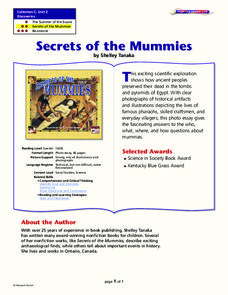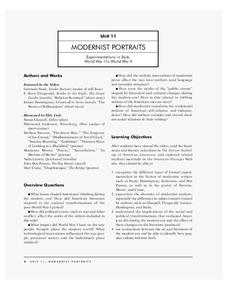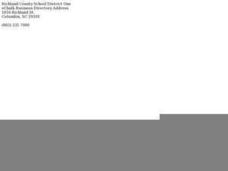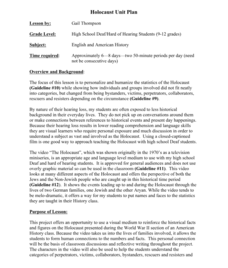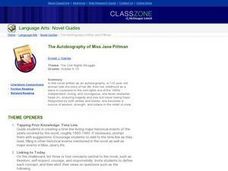Curated OER
Secrets of the Mummies
How did the ancient people of Egypt preserve their dead so well that their bodies are still recognizable today? Learn the painstakingly complex process they used for preservation. Young scholars read and summarize a narrative detailing...
Curated OER
Exploring the Theme of Forgiveness
Help teens explore complex emotions through the true stories of historic and contemporary people.
Curated OER
Classroom Guide for the Redwall Series
Students participate in cross-curricular activities and readings to become familiar with the works of Brian Jacques. In this heroes lesson, students discuss the character traits of legends and how their characters develop through events...
Curated OER
Nationalism in North Africa and the Middle East
Africa and the Middle East are the focus of this Social Studies PowerPoint. After viewing many slides that are packed with historical facts, viewers answer questions such as, "How was the struggle for independence in Algeria different...
Curated OER
Hamilton and Burr : Compare and Contrast
Who were Aaron Burr and Alexander Hamilton? High schoolers examine the character traits of these historical figures and watch the video, The Duel. Hamilton vs. Burr: An Event that Changed History (available from PBS), to gain an...
Vivid Apps
Strip Designer
Let everyone bring out their inner Stan Lee, and practice creating visually-pleasing comic strips that represent and liven up their stories, essays, personal experiences, and the personality of the creator.
Constitutional Rights Foundation
Plyler v. Doe: Can States Deny Public Benefits to Illegal Immigrants?
Illegal immigration is an ever-changing source of consistent controversy. A reading passage about the rights of undocumented workers and illegal immigrants—and the lack thereof—guides high schoolers into a mock trial activity. Three...
US Holocaust Museum
Time Capsule in a Milk Can
Imagine dumping out a milk can and finding letters from one of the darkest moments in history! Scholars use Holocaust Reading Passages and research to discover how people recorded and hid history during the events of World War II. They...
Annenberg Foundation
Modernist Portraits
How did literature reflect people's attitudes in post-World War I America? A lesson explores the topic using a variety of activities. Individuals watch and respond to a video; read author biographies and engage in discussion; write...
Smithsonian Institution
Mary Henry: Journal/Diary Writing
A great way to connect social studies with language arts, a resource on Mary Henry's historical diary reinforces the concepts of primary and secondary sources. It comes with an easy-to-understand lesson plan, as well as the reference...
Smithsonian Institution
Solomon G. Brown: Letter Writing
Personal correspondence in the form of letters is not as common as it once was. This resource presents an opportunity for you to introduce your class to letter writing and cover topics in social studies. Learners read a letter written in...
Curated OER
A Colony is Born : Lesson 5 - Dear Mem
Discover colonies! Young historians will listen to a primary source journal entry read aloud with a backdrop of wave sounds. They discuss the entry, add historical facts to a chart and personal insights to another. Then they listen to...
Center for History and New Media
The Daily Experience of the Laurel Grove School, 1925
What was daily life like for those attending segregated schools in 1925? Modern learners fill out a KWHL chart as they explore historical background and primary source documents about the Laurel Grove School in Fairfax County, Virginia....
Curated OER
Paul Revere's Ride-Fact or Fiction?
Students discuss Paul Revere's ride. In this social studies lesson, students read Paul Revere's Ride and compare the differences between the poem and the historical event.
James Madison Memorial Fellowship Foundation
Those "Other Rights:" The Constitution and Slavery
Did the United States Constitution uphold the institution of slavery, or did it help to destroy it? Young historians study Article 4, Section 2, Clause 3 of the Constitution and evaluate the rights of slaveowners as they compared to or...
Curated OER
Indian Removal
Fourth graders read The Trail of Tears and create a timeline to show the sequence of events that effected the Native American tribes during Andrew Jackson's presidency. In this Native American lesson plan, 4th graders discuss the...
Curated OER
The Impact of History: A Conversation with a Parent
Seventh graders interview parents about certain historical events. In this historical interview lesson, 7th graders create a web of events about historical events. Students interview their parents or grandparents about the event and...
Student Handouts
Comparing Countries’ Constitutions
Analyze the constitutions of five different countries and see how they relate to each country's culture and traditions. Pupils read the preambles to the constitutions of India, Ireland, Russia, Suriname, and the United States. After...
Western Illinois University
Holocaust Unit Plan
Would it have been you? Scholars investigate the horrors of the Holocaust during World War II. They view, interpret, and analyze the video The Holocaust to gain insight into who exactly was impacted by the events Europe. They then...
Curated OER
The Crucible: Hysteria, Witches and Death
Eleventh graders explore the historical events of the Salem witch trials. After completing research and reading a play on the witch trials, 11th graders compare and contrast the historical facts to the fictional play. In groups, students...
Curated OER
A Colony is Born : Lesson 2 - Sez Who?
Second graders increase their baseline knowledge of primary and secondary sources and the likenesses and differences of them with regard to a selected historical event.
Curated OER
The Great Gatsby
Pupils read "The Great Gatsby" by F. Scott Fitzgerald. In groups, they research the events and spirit of the 1920s and relate events in the novel to actual historical events. They compare the characteristics of various genres and...
Curated OER
The Autobiography of Miss Jane Pittman: Novel Guides
Learners create a timeline listing major historical events of the years 1860-1960. They discuss concepts central to the novel, such as freedom, self-respect, courage, and responsibility.



